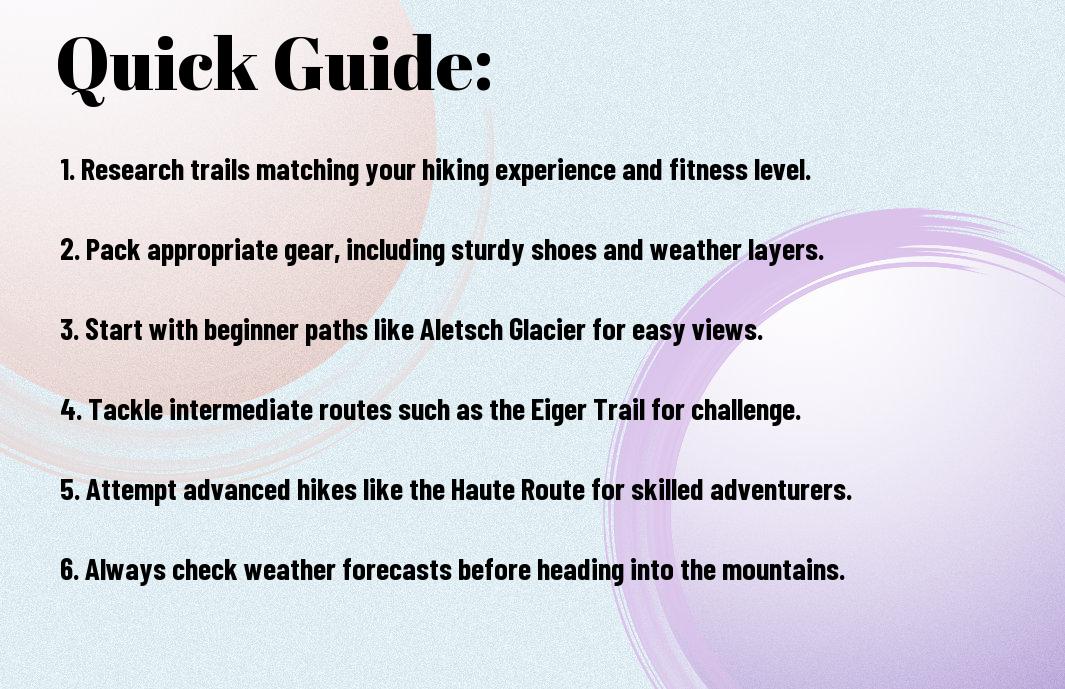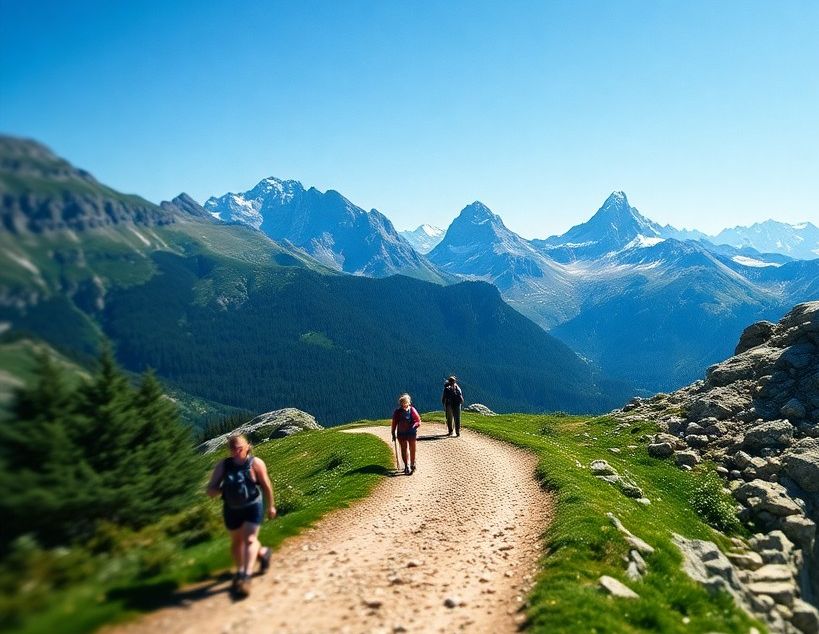Most hikers dream of exploring the stunning Swiss Alps, and you’re about to begin on an unforgettable journey. Whether you’re a beginner or an expert, this guide will help you find the best trails suited to your adventure level. As you trek through breathtaking landscapes, you’ll discover unique wildlife and spectacular views that make every step worthwhile. Just be aware that some routes can be challenging and potentially dangerous, so proper preparation is key to enjoying your time in this alpine paradise safely.
Key Takeaways:
- The Swiss Alps offer a diverse range of hiking trails suitable for beginners, intermediate, and expert hikers, ensuring there’s an option for everyone.
- Popular trails include the scenic routes near Zermatt, the panoramic paths around Interlaken, and the challenging high-altitude climbs to peaks like the Matterhorn.
- Proper preparation and equipment are crucial for safety and enjoyment, regardless of the trail’s difficulty level, due to variable weather and terrain conditions.
Scenic Trails for First-Time Wanderers
Venturing into the Swiss Alps for the first time? You can start with trails that offer breathtaking scenery without demanding technical skills. Routes like the Panorama Trail near Zermatt provide gradual inclines and well-marked paths, showcasing magnificent views of the Matterhorn. These trails are designed to give you a solid introduction to alpine hiking, blending accessibility and awe-inspiring landscapes so you can immerse yourself in nature comfortably and confidently.
Beginner-Friendly Trails: Easy Hikes with Stunning Views
Easy hikes such as the Oeschinensee loop near Kandersteg present manageable distances of 4-6 kilometers, allowing you to enjoy vibrant alpine meadows and crystal-clear lakes. These trails often feature rest stops and minimal elevation gain, making them perfect for building stamina while being rewarded by postcard-perfect vistas. The Sundlauenen to Lauterbrunnen path is another excellent choice, gently winding through wooded areas into dramatic valley views that greet you at every turn.
Family-Friendly Routes: Adventure for All Ages
Trails like the Aletsch Glacier Panorama Trail cater to families by blending educational points with easy walking sections, keeping kids engaged and adults inspired. You’ll find gentle terrain and safe paths here, coupled with spectacular glacier views and informative signage about natural history. This route provides enough variety to satisfy curious young minds alongside adults looking for a relaxing yet invigorating alpine experience.
The Aletsch Glacier Panorama Trail extends roughly 8 kilometers with minimal elevation gain, making it ideal for children as young as six. Alongside the path, interactive installations and guided tours offer insight into the glacier’s formation and climate impact. Availability of nearby picnic areas and playgrounds ensures that you can balance activity with relaxation. With shuttle access from Fiesch, this trail fits comfortably into a family day trip, combining education, exercise, and unforgettable Swiss Alpine scenery.

Conquer the Peaks: Trails That Challenge Your Limits
For those craving an adrenaline rush and demanding terrain, the Swiss Alps serve up trails that push you physically and mentally. These routes, such as the Haute Route from Chamonix to Zermatt or the rugged Bernese Oberland Traverse, offer steep ascents, exposed ridges, and unpredictable weather conditions. Tackling these paths will test your endurance and resilience, rewarding you with breathtaking vistas and a profound sense of achievement. Prepare to face technical sections where precise footwork and steady concentration become as imperative as your stamina.
Challenging Alpine Routes: For the True Hiking Enthusiasts
 The Biancograt on Piz Bernina, often called the “White Ridge,” is a highlight for serious climbers, featuring exposed knife-edge ridges at altitudes exceeding 4,000 meters. Another formidable trail is the Eiger Trail, offering close-up views of the notorious North Face with rugged switchbacks and rock scrambles. Engaging with these routes means mastering alpine techniques and embracing early starts to navigate safely amid rapidly changing weather. The rewarding panoramas and rare bird sightings along these paths underscore just how rich the high Alps can be for adventurous hikers.
The Biancograt on Piz Bernina, often called the “White Ridge,” is a highlight for serious climbers, featuring exposed knife-edge ridges at altitudes exceeding 4,000 meters. Another formidable trail is the Eiger Trail, offering close-up views of the notorious North Face with rugged switchbacks and rock scrambles. Engaging with these routes means mastering alpine techniques and embracing early starts to navigate safely amid rapidly changing weather. The rewarding panoramas and rare bird sightings along these paths underscore just how rich the high Alps can be for adventurous hikers.
Safety and Navigation Tips for Advanced Hikers
Advanced trails demand precision in navigation and preparedness for sudden mountain challenges. Using a detailed topographic map and GPS device together greatly reduces risk, assisting you in tracking your position through complicated terrains like the Dom Hut to Täschhorn route. Checking real-time weather apps and consulting local guides before departure can help you avoid dangerous storms typical in the afternoon. Carrying a well-equipped emergency kit including crampons, an ice axe, and a bivouac sack equips you for unexpected overnight stays.
| Equipment | Purpose |
| GPS Device & Topographic Maps | Precise route tracking and terrain orientation |
| Crampons & Ice Axe | Safe travel over icy or snow-covered sections |
| Weather Apps & Local Guides | Real-time weather updates and expert trail advice |
| Bivouac Sack & Emergency Kit | Protection and survival if stranded overnight |
Proper planning harnesses technology and local knowledge into your safety strategy, enhancing your ability to respond to rapid alpine conditions. Chart your route with detailed maps, estimating your timing for shaded or less exposed trail sections to manage heat and fatigue effectively. Keep in contact with mountain rescue services and register your itinerary if possible. The balance of respect for nature’s unpredictability and your preparedness defines a safe and successful ascent on these challenging Swiss Alpine trails.
| Tip | Details |
| Combine GPS with Physical Maps | Mitigates failures from device batteries or signal loss |
| Start Early | Minimizes weather hazards and maximizes daylight |
| Local Guide Consultation | Access expert insight on trail conditions and hazards |
| Emergency Plan | Include extra food, water, and shelter options in your pack |
Journeying Through the Heart of the Alps
As you traverse the Swiss Alps, the landscape transforms into an awe-inspiring canvas of jagged peaks, lush meadows, and crystal-clear lakes. Each day on these trails immerses you deeper into the alpine culture, as remote villages and ancient alpine huts punctuate your journey. The diversity of terrain challenges you physically while rewarding you with unforgettable vistas, from the iconic Matterhorn to serene glacial valleys. Whether you follow well-marked routes or venture on less-traveled paths, every step connects you intimately with the natural grandeur that defines this region.
Best Multi-Day Hikes & Hut-to-Hut Treks
Embarking on multi-day treks like the famed Haute Route or the Via Alpina allows you to experience the Swiss Alps at a deliberate, immersive pace. Hut-to-hut hiking offers a unique blend of comfort and adventure, as you stay in cozy mountain refuges such as the Cabane du Mont Fort or the Berglihütte. These routes cover diverse terrain—glacier crossings, alpine ridges, and vibrant valleys—letting you savor spectacular panoramas daily while connecting with fellow hikers in authentic alpine settings.
Essential Considerations for Planning Your Route
Planning hinges on the season, your fitness level, and accommodation reservations. Swiss huts fill quickly in peak months, so booking well ahead ensures a spot in these popular alpine sanctuaries. Altitude gains can exceed 1,000 meters daily, so pacing your trek to avoid altitude sickness boosts enjoyment and safety. Weather shifts rapidly above 2,500 meters; equipping yourself with layered clothing and checking forecasts enables you to adapt to sudden changes.
Beyond physical readiness, mapping out rest days and emergency exits sharpens your itinerary. Navigational apps and detailed topographic maps from SwissTopo help you track progress and adjust routes in real-time. Factor in transportation options to and from trailheads, especially in remote areas where public transit frequency varies. Considering these elements not only optimizes your alpine experience but also deepens your confidence exploring this stunning mountain wilderness.
The Allure of Switzerland’s Iconic Landscapes
Switzerland’s landscapes offer more than sheer beauty — they combine dramatic alpine peaks, verdant meadows, and crystalline lakes into a breathtaking mosaic. Each trail leads you through ever-changing vistas that inspire wonder and a deep connection to nature. Whether you find yourself gazing at towering snow-capped mountains or wandering along tranquil forest paths, the diverse terrain keeps every step fresh and exciting. Swiss landscapes invite you to explore and lose yourself in postcard-perfect scenes that are both exhilarating and calming at once.
Iconic Hikes: The Matterhorn, Eiger Trail & Oeschinensee
 Exploring trails near the Matterhorn brings you face to face with one of the world’s most photographed peaks, while the Eiger Trail offers dramatic views beneath the infamous North Face. The trail to Oeschinensee guides you to a stunning alpine lake surrounded by soaring cliffs.
Exploring trails near the Matterhorn brings you face to face with one of the world’s most photographed peaks, while the Eiger Trail offers dramatic views beneath the infamous North Face. The trail to Oeschinensee guides you to a stunning alpine lake surrounded by soaring cliffs.
These hikes vary in difficulty, with the Eiger Trail appealing to intermediate hikers and the Oeschinensee path suitable for families. Assume that each trail encapsulates Switzerland’s grandeur and offers unique moments to connect deeply with the rugged alpine environment.
Capturing the Perfect View: Photography Tips for Hikers
Ideal shots come from lighting during the golden hours of dawn and dusk when the alpine hues are most vivid. Bring a sturdy tripod to stabilize your camera on rocky terrain and a polarizing filter to reduce glare on snow and water. Composing your shot with elements like winding trails or silhouetted peaks adds dramatic depth. Assume that mastering these techniques will elevate your hiking photos, letting you relive and share the magic of Switzerland’s landscapes long after your trek.
Enhancing your outdoor photography experience involves several practical steps that make a lasting difference. Carry extra batteries and memory cards to avoid missing unexpected photo opportunities. Scout vantage points early in the day to find unusual angles, especially near reflective surfaces such as lakes or ice patches.
Keep a lens cloth handy to clear moisture from fog or sudden weather changes. Understanding how weather patterns influence lighting helps you predict the best moments for shots. Assume that engaging fully with your surroundings through photography will deepen your appreciation and your visual storytelling of the Swiss Alps.
- Golden hour lighting maximizes color vibrancy and mood in alpine photos.
- Polarizing filters cut glare and enhance contrast on snow and water surfaces.
- Extra batteries and memory cards ensure readiness for spontaneous shots.
- Scouting vantage points early helps you capture unique compositions.
- Weather awareness allows optimal planning for perfect light conditions.
Timing Your Adventure: Nature’s Calendar
 The Swiss Alps transform dramatically throughout the year, shaping your hiking experience with changing weather and landscapes. From the lush greens and blooming wildflowers of late spring to the crisp, golden hues of autumn, every season offers distinct trail conditions and vibes. Consider the higher altitude trails, often snow-covered until mid-June, while valley routes become accessible earlier.
The Swiss Alps transform dramatically throughout the year, shaping your hiking experience with changing weather and landscapes. From the lush greens and blooming wildflowers of late spring to the crisp, golden hues of autumn, every season offers distinct trail conditions and vibes. Consider the higher altitude trails, often snow-covered until mid-June, while valley routes become accessible earlier.
Planning with local climate patterns in mind helps you maximize trail access and scenic beauty to suit your preferences and skill level.
Best Seasons for Hiking in the Swiss Alps
Late June through September provides some of the most reliable weather for hiking, featuring mild temperatures and mostly clear skies. During this period, alpine meadows are vibrant, and most trails, including iconic routes like the Eiger Trail, are fully open. Early autumn adds a spectacular twist as larch trees shine in golden tones, although cooler temperatures may require layered clothing. Winter hiking is possible but demands winter-specific gear and knowledge due to deep snow and avalanche risks.
Essential Gear for an Unforgettable Hike
Lightweight waterproof jackets, sturdy hiking boots with solid grip, and a well-fitted backpack form the backbone of your gear. Layering is key since temperatures can fluctuate between sunlit valleys and snowy peaks. Carry a detailed topographic map or GPS device, plenty of water, high-energy snacks, and sun protection—including sunglasses and sunscreen. For trails with higher altitudes, trekking poles can alleviate strain and improve balance on rugged paths.
 Delving deeper into crucial gear, high-quality boots with ankle support minimize injury risks on uneven terrain common in Swiss mountain trails. Bringing a multi-tool or pocket knife offers versatility without bulk.
Delving deeper into crucial gear, high-quality boots with ankle support minimize injury risks on uneven terrain common in Swiss mountain trails. Bringing a multi-tool or pocket knife offers versatility without bulk.
A compact first-aid kit should cover blisters and minor injuries, while a portable power bank ensures your phone or GPS stays charged. Additionally, packing a lightweight emergency bivvy or space blanket can provide shelter in sudden weather changes, helping to keep you safe and comfortable throughout your hike.
Final Words
On the whole, exploring the Swiss Alps offers an unforgettable adventure no matter your hiking experience. You’ll find trails suited to your pace and preferences, from gentle walks to challenging climbs, all surrounded by breathtaking scenery. Embrace the journey, take in the fresh mountain air, and let each trail inspire your love for nature. Whether you’re seeking peace, excitement, or a bit of both, the Swiss Alps have something special waiting just for you. So lace up your boots and get ready to create memories that will last a lifetime!
Q: What are some beginner-friendly hiking trails in the Swiss Alps?
A: The Swiss Alps offer several trails suitable for beginners, including the Oeschinensee Loop near Kandersteg, which features scenic lake views and moderate elevation changes. Another great option is the Panorama Trail from Muottas Muragl in the Engadin Valley, providing breathtaking vistas with well-maintained paths. Both trails allow newcomers to experience the beauty of the Alps without requiring advanced hiking skills.
Q: How should intermediate hikers prepare for more challenging trails in the Swiss Alps?
A: Intermediate hikers preparing for more demanding routes should focus on building endurance through regular walking or hiking practice on varied terrain. It is advisable to carry appropriate gear such as sturdy hiking boots, layered clothing for changing weather, and sufficient water. Studying trail maps and checking weather forecasts before starting can enhance safety. Additionally, starting early in the day helps avoid afternoon storms common in mountainous regions.
Q: Are there any high-altitude trails suitable for expert hikers in the Swiss Alps?
A: Yes, expert hikers can challenge themselves with high-altitude trails like the Haute Route connecting Chamonix to Zermatt, which covers rugged terrain and glaciers over several days. Another option is the ascent of the Eiger via the Mittellegi Ridge, known for its technical difficulty and exposure. These trails require excellent physical condition, mountaineering experience, and proper equipment, including ropes and helmets. Hiring a local guide is often recommended for safety on such demanding hikes.

Hi, I’m Laura — a travel writer with a thing for Switzerland and Central Europe. I write practical, down-to-earth guides that help people get the most out of their trips, whether they’re navigating mountain trains in the Alps or finding the best cafés in small Czech towns. I’m based in Zurich, but I’m often on the road, notebook in hand, chasing great views, good food, and local stories. My goal? To make travel feel less overwhelming and way more fun.

